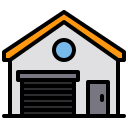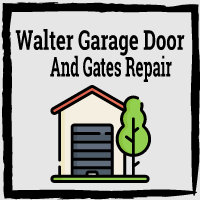Our Mission is to provide outstanding value for all our customers by projecting honesty, integrity and customer values while giving you peace of mind that your needs are met on time by knowledgeable staff members. In order to provide the best solutions for our customers we offer professional services along with providing products from the most respected manufacturers in the industry. We take pride in not only our product offerings, but also in providing high-quality customer service with personal attention.
 Lemuel Bradford2023-08-02My garage door was extremely vulnerable to dents from my children's sporting activities. But, all thanks to Walter and his team, they installed a durable, dent-resistant steel door that withstood impacts. I'm quite happy with their budget-friendly service and family-friendly solution.
Lemuel Bradford2023-08-02My garage door was extremely vulnerable to dents from my children's sporting activities. But, all thanks to Walter and his team, they installed a durable, dent-resistant steel door that withstood impacts. I'm quite happy with their budget-friendly service and family-friendly solution. Amanda Phillip2023-07-28The weatherstripping on my garage door had deteriorated, leading to energy loss and drafts. Luckily, Walter's technicians promptly installed new weatherstripping, effectively sealing the door and providing better insulation. I noticed a significant improvement in temperature regulation and energy efficiency. Their professionalism and excellent service deserve commendation. Thank you so much!
Amanda Phillip2023-07-28The weatherstripping on my garage door had deteriorated, leading to energy loss and drafts. Luckily, Walter's technicians promptly installed new weatherstripping, effectively sealing the door and providing better insulation. I noticed a significant improvement in temperature regulation and energy efficiency. Their professionalism and excellent service deserve commendation. Thank you so much! Heather Nelsen2023-07-27I had a great experience with this garage door repair service. The team was responsive and scheduled an appointment for the same day. The technicians arrived on time and were well-prepared. They diagnosed the problem with my garage door and provided me with a clear explanation of the necessary repairs. The service was completed promptly and professionally. I am impressed with the quality of their work and will certainly turn to them again for any future garage door needs.
Heather Nelsen2023-07-27I had a great experience with this garage door repair service. The team was responsive and scheduled an appointment for the same day. The technicians arrived on time and were well-prepared. They diagnosed the problem with my garage door and provided me with a clear explanation of the necessary repairs. The service was completed promptly and professionally. I am impressed with the quality of their work and will certainly turn to them again for any future garage door needs. A Google User2023-07-02I had been experiencing issues with my garage door sensors, causing the door to stop unexpectedly. I called this garage door service, and they sent a technician right away. They not only fixed the sensor problem but also performed a thorough inspection to ensure everything was in working order. Great service and peace of mind!
A Google User2023-07-02I had been experiencing issues with my garage door sensors, causing the door to stop unexpectedly. I called this garage door service, and they sent a technician right away. They not only fixed the sensor problem but also performed a thorough inspection to ensure everything was in working order. Great service and peace of mind! Marilyne Bernhard2023-06-28I recently had my garage door replaced by this company, and I couldn't be happier with the results. The installation process was smooth, and the new door looks fantastic. The team was knowledgeable, skilled, and efficient. I appreciate their attention to detail and would definitely recommend their services.
Marilyne Bernhard2023-06-28I recently had my garage door replaced by this company, and I couldn't be happier with the results. The installation process was smooth, and the new door looks fantastic. The team was knowledgeable, skilled, and efficient. I appreciate their attention to detail and would definitely recommend their services. Earlene Gutierrez2023-06-01This morning while closing my automatic garage door a cable snapped. The door was half shut. I called Walter when they opened at 8:00 am. Walter told me he could be at my home in 20 minutes. He was true to his word. Walter and his assistant were able to install two new cables in 45 minutes. Walter and his assistant gave me helpful advice on preventive maintenance. Highly recommend this company.
Earlene Gutierrez2023-06-01This morning while closing my automatic garage door a cable snapped. The door was half shut. I called Walter when they opened at 8:00 am. Walter told me he could be at my home in 20 minutes. He was true to his word. Walter and his assistant were able to install two new cables in 45 minutes. Walter and his assistant gave me helpful advice on preventive maintenance. Highly recommend this company. Sonya Meyers2023-05-31Very pleased with our new garage doors springs. Walter came out quickly when our original garage door springs broke and provided us with an explanation of our issue and a reasonable quote to replace the garage door springs. The quality of the new springs is great and Walter did an excellent job of installing them.
Sonya Meyers2023-05-31Very pleased with our new garage doors springs. Walter came out quickly when our original garage door springs broke and provided us with an explanation of our issue and a reasonable quote to replace the garage door springs. The quality of the new springs is great and Walter did an excellent job of installing them. Clyde Mercado2023-05-26Fantastic service from this business. Walter fixed our door effectively at a comfortable price and was fast, polite, and professional. After we called them, an appointment was made, and they came out really quickly to fix the problem. I would definitely recommend him to my colleagues.
Clyde Mercado2023-05-26Fantastic service from this business. Walter fixed our door effectively at a comfortable price and was fast, polite, and professional. After we called them, an appointment was made, and they came out really quickly to fix the problem. I would definitely recommend him to my colleagues. Damien Harris2023-05-23We would like to say a huge thank you for his quick response and excellent job. Our garage door works without any hassles, and we are surprised at how quiet it is. Very happy with the service. I would definitely recommend them.
Damien Harris2023-05-23We would like to say a huge thank you for his quick response and excellent job. Our garage door works without any hassles, and we are surprised at how quiet it is. Very happy with the service. I would definitely recommend them. Rebecca Harper2023-05-15I called Walter for my annual maintenance and I am very happy with the service. My garage door was properly tuned up. The bearings as well us the hinges were lubricated. My garage door works smoothly after the service. I am very happy and satisfied with his professionalism. Thank you.Google rating score: 5.0 of 5, based on 13 reviews
Rebecca Harper2023-05-15I called Walter for my annual maintenance and I am very happy with the service. My garage door was properly tuned up. The bearings as well us the hinges were lubricated. My garage door works smoothly after the service. I am very happy and satisfied with his professionalism. Thank you.Google rating score: 5.0 of 5, based on 13 reviews

If you're looking for a professional garage door installation service, then you've come to the right place. Let Garage Door Repair Costa Mesa, CA team of experts help you out with any project large or small. Our technicians will take care of everything for you and make sure that your brand new garage door opener is exactly the way it should be, without any problems.
A garage door is one of the important parts of your house. It will not just keep the items in the garage safe, but it can also be a decorative part of your home. The importance and functionality of a garage door are all that much more important when it comes to safety because they can prevent intentional intrusions into your house as well as unintentional accidents involving small children. That's why if you're experiencing problems with you garage door, it is best to call Walter Garage Door And Gates Repair Costa Mesa, CA and get your garage door repaired right away.


Garage door springs are an important part of your garage door. They help the garage door open and close, so when hanging a new one, it's imperative that you have a professional to do the job for you. Once they've replaced your old spring with a fresh new one and resealed your entryway, it will be able to withstand more weight every time and provide years of service.
In most cases, garage doors are not a primary entry-exit for the home. This means that many homeowners don’t take the time to perform regular maintenance on their door. This carelessness can be costly when problems arise and can also affect the safety of home occupants. In an effort to discourage neglect, we’ve included this list of do's and don'ts for maintaining your garage door.
Clear out debris: Regularly remove debris from underneath your door so it doesn't get caught in roller tracks or prevent alignment with the jamb when opening and closing.
• Wipe up oil, grease and other liquids from the floor to prevent damage to the door from corrosive materials.
• Keep your garage door clear of any items that may weigh it down or strain its operation.
Ease Tension: Check the tension on springs about once a month and adjust as needed for smooth operation.
• Make sure torsion springs aren’t overloaded, and tension adjustments are made with care. Don’t overtighten them because they may break while in use, potentially harming occupants or damaging property.
• Adjust spring tensions evenly to prevent uneven wear on the tracks and rollers resulting in sticking or sagging doors.
Check operation: Perform safety checks monthly to ensure your door is working properly.
• Test your lift and tilt mechanisms to ensure they work smoothly and hold their positions correctly.
• Test your safety reversers or limit controls. If your door’s reverse mechanism malfunctions, it may close suddenly, causing damage to the door or injury to an occupant.
• Test all light bulbs and replace them as needed. A burnt-out bulb can cause a fire hazard in the garage since lights are very useful when performing tasks such as working on automobiles or gardening equipment.
• Make sure your door will not reverse when you open it. Over time, your door may start closing on you as the spring and cable wear down, especially if the weight of the door and its contents are heavy.
• Test your emergency release mechanism to ensure that it works in case of power outage or door jamming.
Check for damage: Check for signs of physical damage regularly to ensure that your garage door will continue to operate safely and efficiently.
• Look for stains or rusting on tracks, rollers, hinges and springs as these are common signs of wear due to regular use.
• If your door develops deep dents, take note of the type of material that is denting the door. For example, if you find dents in a sheet metal door, your garage may have an improperly insulated floor or an underground pipe leak.
• Check for cracks in the door’s paint and surrounding structure as these are telltale signs that the supporting framework is deteriorating.
Repair/replace parts: Repair or replace parts as needed to restore your door to proper working order.
• Replace chains or cables if they are frayed or if you see excessive wear from tension adjustments. The garage can be a dangerous place if cables snap while in use because of excessive wear.
• Inspect rollers as they may need to be replaced if they are worn or missing.
• Replace damaged or missing hardware on hinges, locks and safety releases.
• Reset safety reversers if your door suddenly opens into traffic or if it fails to retract when you open it.
Avoid damage: Minimize the potential for damage by following these tips:
– Keep your garage door securely mounted to a wall or a floor that allows for proper alignment with jamb and hinge pins. Do not mount the door on heavy objects like boxes as this can cause the door to sag or bind.
– Don’t overload the door with extra weight by storing items on it.
– Don’t transport chemicals or corrosive materials in your garage as they can damage the door and harm occupants.
• If you are building a new garage, consider making the floor and walls out of non-porous, water-resistant materials to prevent moisture damage.
The garage door track plays an important part in keeping the overhead garage door aligned properly. In fact, a poorly aligned track can result in the door not functioning properly. A loose track is a serious problem since it could allow the door to fall and create so much of trouble. In fact, you or a member of your family can become seriously injured if the door falls when you'll are near it. That is why you need to a reliable company to deal with garage door track repairs immediately.
Brackets are used to hold the garage door tracks. They are attached to the door frame. The end of the overhead portion of the track is suspended with steel channels from the ceiling. These tracks should be parallel with each other for the garage door to open and close properly. Repairing garage door tracks is not the best DIY project, especially if you don't have any mechanical experience. You can easily injure yourself if you don't know what you are doing. That is why you need to work with a professional garage door repair company in town.
